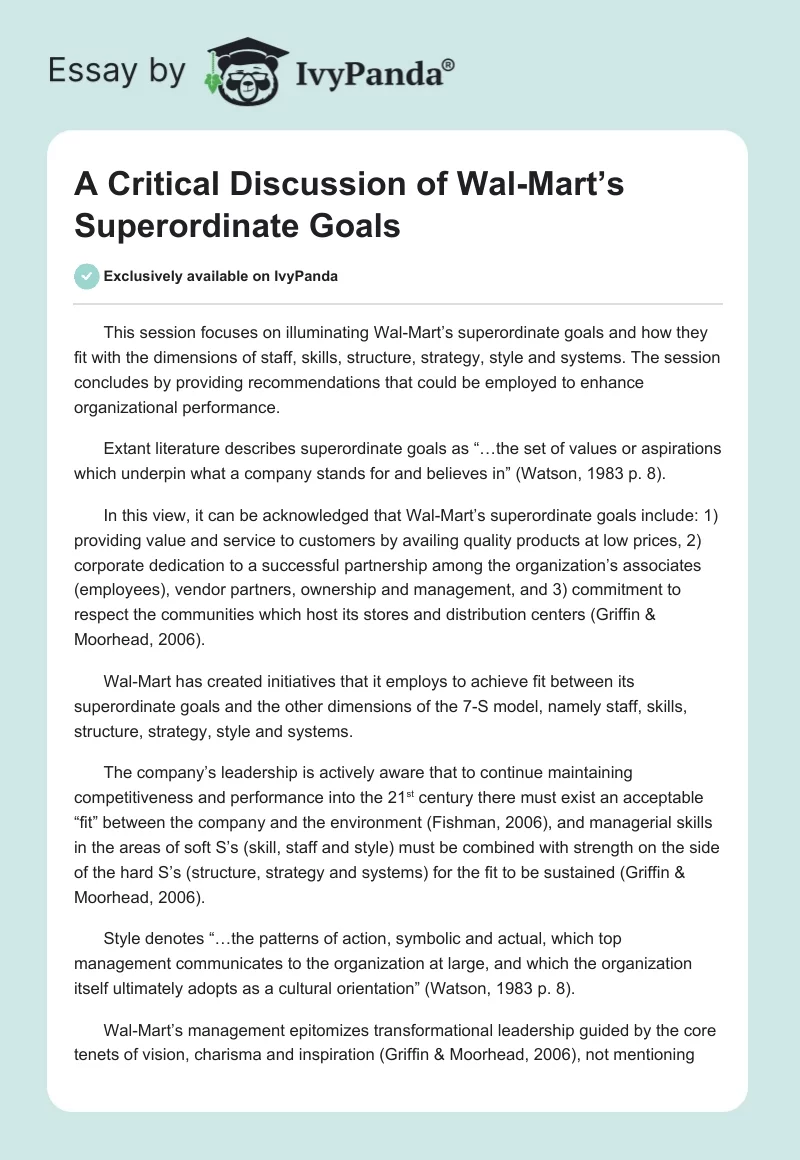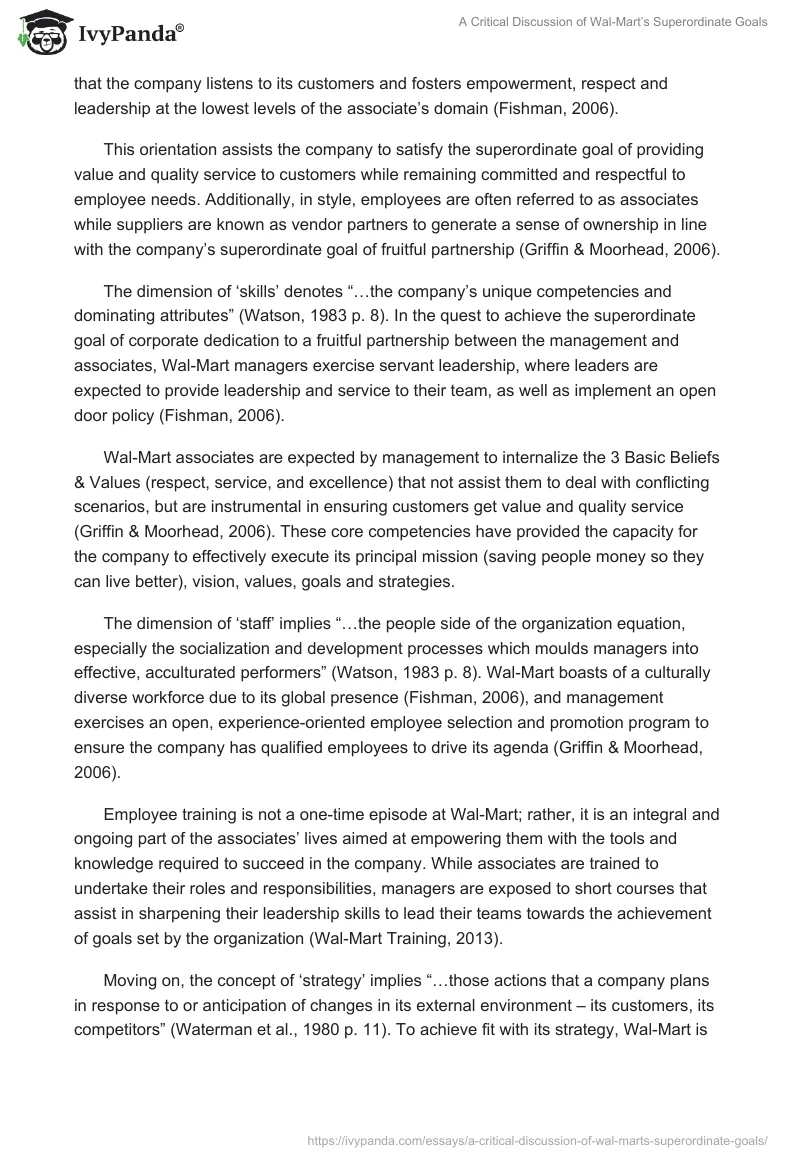This session focuses on illuminating Wal-Mart’s superordinate goals and how they fit with the dimensions of staff, skills, structure, strategy, style and systems. The session concludes by providing recommendations that could be employed to enhance organizational performance.
Extant literature describes superordinate goals as “…the set of values or aspirations which underpin what a company stands for and believes in” (Watson, 1983 p. 8).
In this view, it can be acknowledged that Wal-Mart’s superordinate goals include: 1) providing value and service to customers by availing quality products at low prices, 2) corporate dedication to a successful partnership among the organization’s associates (employees), vendor partners, ownership and management, and 3) commitment to respect the communities which host its stores and distribution centers (Griffin & Moorhead, 2006).
Wal-Mart has created initiatives that it employs to achieve fit between its superordinate goals and the other dimensions of the 7-S model, namely staff, skills, structure, strategy, style and systems.
The company’s leadership is actively aware that to continue maintaining competitiveness and performance into the 21st century there must exist an acceptable “fit” between the company and the environment (Fishman, 2006), and managerial skills in the areas of soft S’s (skill, staff and style) must be combined with strength on the side of the hard S’s (structure, strategy and systems) for the fit to be sustained (Griffin & Moorhead, 2006).
Style denotes “…the patterns of action, symbolic and actual, which top management communicates to the organization at large, and which the organization itself ultimately adopts as a cultural orientation” (Watson, 1983 p. 8).
Wal-Mart’s management epitomizes transformational leadership guided by the core tenets of vision, charisma and inspiration (Griffin & Moorhead, 2006), not mentioning that the company listens to its customers and fosters empowerment, respect and leadership at the lowest levels of the associate’s domain (Fishman, 2006).
This orientation assists the company to satisfy the superordinate goal of providing value and quality service to customers while remaining committed and respectful to employee needs. Additionally, in style, employees are often referred to as associates while suppliers are known as vendor partners to generate a sense of ownership in line with the company’s superordinate goal of fruitful partnership (Griffin & Moorhead, 2006).
The dimension of ‘skills’ denotes “…the company’s unique competencies and dominating attributes” (Watson, 1983 p. 8). In the quest to achieve the superordinate goal of corporate dedication to a fruitful partnership between the management and associates, Wal-Mart managers exercise servant leadership, where leaders are expected to provide leadership and service to their team, as well as implement an open door policy (Fishman, 2006).
Wal-Mart associates are expected by management to internalize the 3 Basic Beliefs & Values (respect, service, and excellence) that not assist them to deal with conflicting scenarios, but are instrumental in ensuring customers get value and quality service (Griffin & Moorhead, 2006). These core competencies have provided the capacity for the company to effectively execute its principal mission (saving people money so they can live better), vision, values, goals and strategies.
The dimension of ‘staff’ implies “…the people side of the organization equation, especially the socialization and development processes which moulds managers into effective, acculturated performers” (Watson, 1983 p. 8). Wal-Mart boasts of a culturally diverse workforce due to its global presence (Fishman, 2006), and management exercises an open, experience-oriented employee selection and promotion program to ensure the company has qualified employees to drive its agenda (Griffin & Moorhead, 2006).
Employee training is not a one-time episode at Wal-Mart; rather, it is an integral and ongoing part of the associates’ lives aimed at empowering them with the tools and knowledge required to succeed in the company. While associates are trained to undertake their roles and responsibilities, managers are exposed to short courses that assist in sharpening their leadership skills to lead their teams towards the achievement of goals set by the organization (Wal-Mart Training, 2013).
Moving on, the concept of ‘strategy’ implies “…those actions that a company plans in response to or anticipation of changes in its external environment – its customers, its competitors” (Waterman et al., 1980 p. 11). To achieve fit with its strategy, Wal-Mart is moving into sections of the U.S. market with less floor space but with a high population of people to take services closer to its customers.
Presently, the company is providing smaller-format stores, elevating marketing /advertising initiatives, actualizing same-day delivery services and engaging in more e-commerce capabilities, not only to enhance customer service experience but also to position itself more favorably with respect to competitors (Cheng, 2012). Additionally, the company’s continuous training and development program create quality-conscious employees who have the capacity to demonstrate respect and provide quality service.
Systems imply “…all the procedures, formal and informal, that make the organization go, day by day and year by year” (Waterman et al., 1980, p. 11). Wal-Mart boasts of several effective and efficient systems, including capital budgeting systems, employee training systems and cost accounting procedures, but the most profound is the Supply Chain Management System (SCMS), which is fundamental in achieving fit between the organization’s structure and strategies.
In the increasingly complex SCMS, the management first decides on what is to be sold in the superstores based on customer needs and, afterwards, consults vendor partners to find out where those products can be sourced from. The management then decides on how much it wants to sell based on sales statistics as well as current and historical trends.
It is important to note that this forecasting holistically determines inventory and distribution needs by estimating how much of what product is needed in specific store/distribution locations (Griffin & Moorhead, 2006). This integrated system ensures excellent service delivery.
The last dimension deals with structure or basically how an organization is organized to effectively execute strategy (Waterman et al., 1980). Wal-Mart’s structure, which is essentially decentralized (authority delegated to lower management echelons) and relies on managerial hierarchy as well as rules and procedures, has been outstandingly designed to facilitate the attainment of the company’s vision, goals and mission (Griffin & Moorhead, 2006).
One manager is placed in charge of people, groups or departments having interdependent functions, with the view to ensure coordination and minimize conflict, hence spurring performance. Wal-Mart exercises strict cost control so that it is able to actualize its low-cost strategy to its customers, not mentioning that it emphasizes a market departmentalization structure to provide superior services to diverse types of markets – local and international (Fishman, 2006).
Going by recent expansion programs and increased sales revenue (Fishman, 2006), it can be argued that Wal-Mart has been successful in aligning its superordinate goals (value and service to customers; fruitful partnership with associates; respect to community) with the other aspects of the 7-S model.
However, the superordinate goal of fruitful partnership with associates needs to be streamlined to solve accusations of poor working conditions, poor employee remuneration, and racial and gender discrimination (Fishman, 2006).
These accusations continue to dent the company’s image and reputation, not only in the U.S. but also globally. In effect, the streamlining of this goal entails designing and implementing policies that will empower employees and ensure equality of opportunities.
References
Cheng, A. (2012). Wal-Mart outlines strategy. The Wall Street Journal. Web.
Fishman, C. (2006). The Wal-Mart effect: How the world’s most powerful company really works – and how its transforming the American economy. New York, NY: Penguin Books.
Griffin, R.W., & Moorhead, G. (2006). Organizational behavior: Managing people and organizations (9th ed.). Stamford Connecticut: Cengage Learning.
Wal-Mart training and development. (2013). Web.
Waterman, R.H., Peters, T.J., & Phillips, J.R. (1980). Structure is not organization. The McKinsey Quarterly, (3), 2-20.
Watson, C.M. (1983). Leadership, management and the seven keys. Business Horizons, 26(2), 8-13.


